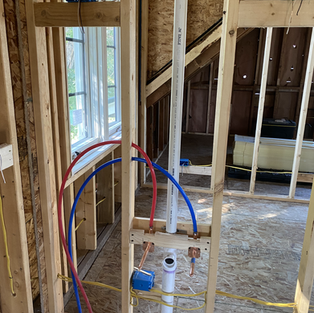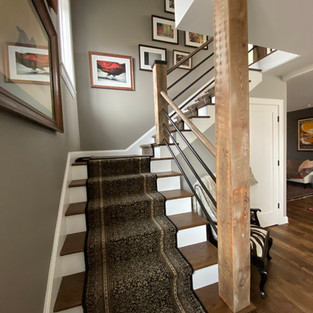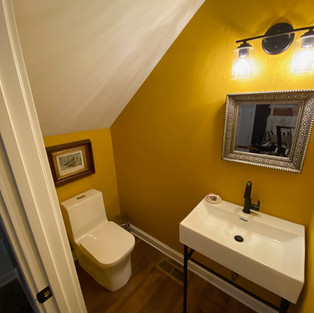Livingston MT renovation
- Johan and Pam

- Dec 17, 2020
- 18 min read
Updated: Jan 20, 2023

Located in the town of Livingston MT on 1/4 acre (3 city lots), this 1900 house was renovated in 2020. The home had been owned and well lived in by one family since 1984 but may have originally been a two-flat as it had front and back staircases and an oddly configured 2nd floor. The property included a large garage and a very old shed.
The house, while lived in hard over 100 years, had good bones, a solid foundation, and a sturdy sewer system. Minimal updating had been done to the property so it was ripe for a gut renovation. The knob and tube wiring need to be replaced, there was no central heat, and the water in the upstairs bath did not work. The front spiral staircase was a hazard -- built out of cinder blocks and wood. The 2nd floor had different levels which meant that the ceiling heights varied between tiny rooms.
With Johan's expertise and Pam's design and project management skills, we would undertake this project from design to build ourselves and hire specialists only where required by code.
See video (right) for a tour of the original house.
The Plan

A plan was made to gut the house to the studs and raise the roof to create cleaner roof lines while opening the space for better configuration. The house footprint would not change and the 1900s look and feel of the house exterior, particularly in the front, would be retained. The interior would be brought into the 21st century and up to code. The house would be sided in wood and cedar shakes, using the original siding, and the front porch opened.
The back staircase would be removed so that the kitchen could be made larger with direct access to the expansive backyard. The space occupied by the bedroom on the first floor would be made into a home office, and a powder room would be created under a new staircase. The first floor full bath/laundry space would be removed and the laundry relocated to the 2nd floor. Raising the roof and opening the walls would allow the 2nd floor space of 4 bedrooms and the inoperable bath to be reconfigured into 3 bedrooms and 2 full baths. All windows needed to be replaced.
Designs for the kitchen and baths were developed utilizing houzz for inspiration.
Under several layers of 1970s-1980s shag carpeting and even older linoleum there were wood floors. Perhaps they could be salvaged. Maybe some of the doors and hardware could be repurposed. The old lumber from the shed also presented some re-use opportunities.
In mid 2019 Johan gutted the 2nd floor, some of the first floor, and removed the spiral staircase. The chain link fence and overgrown shrubs in the front were also removed though the property will not be landscaped until spring 2021. An architect was hired to draw plans for submission to the city for a permit, and a framing contractor was brought in to handle the roof removal and re-framing, remove the back part of the 1st floor ceiling and add engineered beams. In these plans the back and side walls would not need to be removed.
The reframing work was planned for early January 2020. By the end of March, work had not begun and the world was locked down due to the pandemic. The house had to be habitable by fall 2020 (we had sold our house in Chicago and had a short-term rental in Livingston).
Demo and Rebuilding
Structural demo began April 20 and took slightly less than 2 weeks. Once the structural gut work was underway it became clear that it would be better to replace the back wall entirely, along with the subflooring in the back of the house since the pitching was more severe than it looked. Once the back wall was removed, along with the kitchen and dining room windows on the south side of the house, a portion of the south side wall was also removed. A bump out, further enlarging the kitchen and dining space, could be added quickly at a small cost.
Rebuilding began May 1 and took about 60+ days including the bump out (which included new foundation support), roofing, and house wrap. The 2nd floor windows ordered in December 2019 (selected based on the exterior design plans and 2nd floor configuration) were installed by Johan. We waited until the rebuild was further along to decide on the 1st floor windows and exterior doors placement. Being in a space as opposed to seeing it on paper makes a huge difference. An error was made (guaranteed to happen in renovation and construction) in the 2nd floor front window size and it needed to be reordered.
By June 30, several challenges had to be addressed:
Schedule: our rental lease was through August; we had already extended the lease through Sept. Realistically, we would need another month through October. We had started out 3 months behind but made up some time. We needed to make up more.
Cost: we spent a bit more on the framing, bump out, and roofing tiles, plus we had to buy a new front window, and pay 2 extra months of rent. Because of the extent of the demo, the original wood siding could not be used.
Supply chain: the pandemic was limiting the availability of building materials, appliances, cabinets, countertops, fixtures, and more.
We evaluated the house plans to see where we could save some time and money without compromising quality or our vision.
The house had a small cellar space in the far southeast corner and it was assumed that this space would be used to place the furnace and hot water heater. A door to the cellar would need to be dug out from the outside of the house for this to work.

We examined the 1st floor plan. The space allocated to the home office on the 1st floor grabbed our attention, along with the side entryway. Would it make more sense to have the side entry hall open into a large mudroom where we could place the house mechanicals and create abundant storage for hiking gear, coats, boots, and more, instead of opening into the kitchen? Moving the furnace to a central location on the 1st floor would be more efficient and save time. The "mistake" window from the 2nd floor could be used in this space, adding good northern light to the 1st floor. The space was big enough that we could also add a doggie shower, a cost savings feature that could be built inexpensively.
For the rest of the 1st floor, did we need to create separate rooms? What if the first floor was an open space except the powder room under the stairs and the mudroom? In an open floor plan we would not need as many windows yet still have ample light. We adjusted the layout and shaved weeks off the build and thousands off the costs. The changes improved on our vision.
Opening the porch would have to wait until 2021.
Mechanicals
While the structural work was underway, HVAC contractors were interviewed and bids solicited so that a contract was signed with Rick's Refrigeration by early June. The HVAC ductwork needed to be installed before the house could be insulated and drywalled, and the work was completed promptly. The house was simultaneously wired, and new electrical service was organized with a certified electrician and the utility company. The placement of the gas line, which was moved from the original location to accommodate double french doors to the outside back yard, was coordinated with the gas company. Water supply and waste lines were installed. By late August the mechanical work was complete and the house was insulated, drywalled, patched, and sanded.
Interior Details
Pam began the search for appliances, fixtures, kitchen cabinets, doors, and hardware in June. We did not have time to make multiple trips to stores in larger cities such as Bozeman or Billings (30 mins and 1.5 hrs each way, respectively), and wanted to limit our exposure to nasty viruses since getting sick or quarantined would have been ruinous to the schedule. Pam searched online, contacting local stores to purchase as much as possible locally. Four to 8+ weeks was allocated for delivery. While not seeing items real time has some disadvantages, it also reduces sales pitch and pretty shiny object distractions which can cause unending deviation from a design plan and eat up time (and money).

After the appliances were ordered from a store in Bozemen (items selected based on research and previous experience with the brands and ordered over the phone to negotiate a "bulk" discount), kitchen cabinet plans were drafted by Johan based on Pam's design and submitted to Home Depot, IKEA, and a local kitchen cabinet store by July 1. Getting a final plan and price estimate from HD required a lot of follow up and had to be done out of the Helena store via phone, email, and Zoom. To see samples, we would have to drive to Helena (2 hrs each way). IKEA's design services, offered online and via video call with a 2 week lead time, were excellent, and their cabinets were the lowest priced but they did not have all items in stock. Because IKEA could not provide an estimated time for delivery they had to be eliminated.

At the recommendation of a friendly neighbor we met while walking our dogs, we took our design to Livingston Home Outfitters / Crazy Mountain Cabinetry. They had a cabinet model from an employee-owned cabinet maker in SD that was very close to our design, and their cabinets were priced comparably to Home Depot. Brad Rabe worked closely with us on our design and budget, with great attention to detail, to get us what we wanted. Our design was a bit unusual -- 3 different cabinet materials, almost all drawers, and lazy susan corner cabinets stacked. They saved us money by recommending that we order cabinet organization and pull components or knobs from other sources and do so after the cabinets were installed. We saved substantially by shopping for these items on Wayfair and Build (IKEA selection and availability continued to be limited). Glass inserts for the upper cabinets were purchased from a local glass store on a good schedule for much less than having the cabinet maker install them. Never buy internal storage, hardware, or glass panels from a cabinet maker unless money is no object (except for large built-in lazy susans).
Pricing for the countertops was nearly double what we had estimated due to demand and our now more remote location (vs Chicago). Bozeman countertop stores were contacted to see if we could improve on the countertop price. Yes, we could get a slightly better price but we discovered a new problem: scheduling. The Bozeman suppliers would not be able to install until February 2021. We bit the bullet and ordered the countertops we wanted on the schedule we needed. Brad stayed on the countertop contractors to keep them on schedule. This was a huge help as it eliminated the time we would have had to spend overseeing another supplier.
The original flooring design plan called for tile in the bathrooms and hardwood flooring throughout the rest of the house. We had saved the original hardwood flooring but there was not enough of it for the entire house (we will use it for studio space we plan to build over the garage). Multiple decisions needed to be made, materials procured, and much time allocated for installation (install, sand, stain, and varnish, and tile in 3 bathrooms). In the meantime, the 1st floor windows had arrived but the order was in error: the casements delivered were not what we paid for. Time had to be devoted to getting the window company to correct their error. It took 3 attempts and nearly 3 months to get the right windows.

Shopping online for the variety of flooring we needed was proving difficult. It took too long to get samples, was impossible to identify color and texture online, and inventory availability often unclear. We turned to a local flooring store, Livingston Flooring. Kevin, the owner, recommended quality laminate flooring that was easy to install, reasonably priced, waterproof, and in stock. We have a Newfoundland dog. Waterproof hardwood-look floors have come a long way in recent years. They seemed a perfect whole house solution. By ordering such a significant quantity (nearly 2000 square ft) we got a good price. Our order could be delivered in 2 weeks. The decision to use one type of flooring throughout saved time and money. It looks great and is holding up nicely with our dogs.
Recessed lighting was installed throughout the house except for the bedrooms, thus reducing the need to select lighting fixtures in advance (except for the kitchen island pendants and bath lighting) before we moved in. In our experience, it is better to wait until painting is completed and everything is in place before selecting lighting fixtures or ceiling fans. These were later ordered from Urban Ambiance and LampsPlus, both with generous return policies, prompt delivery, and good pricing.

Custom bath vanities were eliminated given the time frame and cost. What could we get quickly and inexpensively that would be close to the original design? After researching local off the shelf and online options, Pam found cabinets on Wayfair that could be sized to fit the master bath, and another that matched for the guest bath. The cabinets were a perfectly priced solution as long as the quality was decent but Johan's experience with Wayfair had been hit and miss. We tweaked the bath design and placed the order, hoping for the best.

Bath and kitchen sinks and fixtures, mirrors, lighting, toilets, and door hardware were ordered from a combination of Home Depot, Wayfair, Build, Rejuvenation, and Restoration Hardware based on availability, price, and design. It is wise to buy quality fixtures for those spaces that get the heaviest use such as the kitchen and baths and go with less expensive options for lower traffic spaces like a powder room. Items were ordered well in advance (6+ weeks) of when they would be needed for installation so that if we didn't like them or they were damaged there would be time to return and replace. One of the bath mirrors arrived damaged and had to be re-shipped. We decided to hold on ordering fixtures for the 1st floor powder room until after we moved in (those fixtures were later ordered and arrived damaged; Build replaced them asap).
The Supply Chain Tightens
Supply chain problems got weird. In September, circuit breakers became scarce. Everyone was out of them in Livingston and Bozeman. Pam scrambled to find them online from 4 different sources. House siding and interior moldings (baseboards and window casements) were also proving challenging. We bit the bullet and drove to Billings and knocked on the door of the largest building supplier in the country. The workers let us in (in spite of being closed to the public), showed us their inventory, and explained that siding manufacturers were backed up until 2021 Q1, maybe even Q2, due to reduced plant capacity and lumber price increases. Prices had doubled. We also visited a wood products business and contacted milling operations for molding. We could not find what we wanted, or anything close. Phone calls and emails were not returned. This was getting frustrating so it was decided to put siding and moldings on hold while we focused on making the house habitable by Oct 30.

Attention turned to doors. We decided that a consistent look was important so would not repurpose the original doors (some of which were not worth saving). We selected barn doors for the bedrooms and baths, and the mud and laundry rooms. Hanging doors would be used for the master bed suite, powder room, mudroom closets, and front, side and back doors. We wanted all the doors to have a consistent look, regardless of type. Doors were now in high demand, prices rising. Options would vanish before the "buy" button could be clicked; orders were mysteriously canceled. Due to the supply chain problems they had to be procured from a combination of Home Depot, Wayfair, Build, and the local lumber store (Kenyon Noble). The bedroom and bath doors arrived quickly but the others became something of a comedy. One set of doors was delayed in a locked container that no one had the keys to. Eventually 3 doors were ordered where one was needed with the hope that one of them would arrive in a timely fashion and would work, and that we could return the others. By mid-December all the doors arrived. One of the two extra doors was returned and the other that could not be returned for a full refund will be used in the future garage build out.

Selecting bath and kitchen tile online also proved challenging. Pam started searching in July, ordered samples (a few of which cost a small fee), and we trekked to Home Depot but could not find what was typically in stock -- an inexpensive, high quality, and timeless Daltile white for the baths. We were flexible about the tile for the shower stall bases. The local store options were pricey. We decided to try one store in Bozeman during a Home Depot supply run, The Flooring Place. A good sales person provides meaningful value, and that we got. The sales woman showed us options within our budget likely to be in stock, gave us samples, and confirmed availability. We were also able to order quartz shower thresholds from this store, cut to our specifications, at a good price. One of the online kitchen tile samples arrived after we placed our order with the store. The sales person confirmed that it was a good tile and price. It was about the same price as the in-store option (which confirms that you pay shipping one way or the other) but better matched our design. The online store, Tilezz, followed up with the freight company quickly when the shipment was held up in Denver. The tile arrived on time and in perfect condition. Tile from The Flooring Place arrived promptly, and they were quick to replace an incorrectly cut threshold.

The interior work that would make the house habitable - flooring, baths, kitchen installation, tiling, and more began early September. Fortuitously, our 19 yo nephew decided to spend the fall with us when he was unable to go back to school in Vermont. What he lacked in carpentry skills he made up for in brawn, and having an extra pair of hands was really helpful. Duncan spent the fall installing flooring, tiling, staining, digging, moving boxes, and fetching materials from Bozeman. In return, we helped him adopt a rescue dog and took him on some glorious Montana and Yellowstone hikes.
The Final Push
The work throughout September and October felt chaotic but was carefully orchestrated. The flooring needed to be delivered and installed before the appliances arrived. The cabinets had to be installed to meet the date the countertop contractors were scheduled to measure so that the counters could be delivered on time, and then the kitchen tiling had to be finished before the upper cabinets and range hood could be installed. Everything had to arrive on time which required a flurry of emails and phone calls to confirm. Livingston Home Outfitters, Livingston Flooring, and Guy's Glass all came through in a big way. A solution for the bathroom countertops -- and one that would not cost a lot -- had yet to be found. We were seriously considering using plywood.

Serendipity is a beautiful thing. When dropping off a check at Livingston Home Outfitters we saw a nice piece of wood -- a butcher block-like countertop made of strips of oak glued together. The price was more than right -- for less than $1000 we could get enough for the master and guest baths, and laundry room. The wood was unfinished and would have to be stained and varnished. Johan would do the sink cut outs. This solution required a bit more time but was a lot less money than quartz -- and it could be delivered within 2 weeks. When Johan was unable to find drum sanders at the local hardware store, a customer offered some from his stash, proving the friendliness of a small town, even during a pandemic. We don't know how the wood will hold up but it should prove a solid investment as it can be re-sanded if it ever needs refreshing.
We needed at least one operable bath by Oct. 30 which meant that we had to get shower glass -- fast. We found an online option that looked like it could work but it meant that we had to rely on the glass arriving on time, in perfect condition. Johan, with Duncan, would have to install it. The money saved going this route would be significant (about 50%) but it was risky. After much consideration, it was decided to contract with Guy's Glass for the shower glass. He could install it on the schedule we needed. Later events would make this decision really right (Pam slipped on black ice and broke her wrist in late Oct and had to have surgery).

Fencing became another supply chain issue. The yard needed to be fenced for the dogs. Fencing material is always available at Home Depot or Lowe's for a reasonable price. Not so now. Prices had doubled, inventory was depleted. It could not be ordered online or delivered. Pam kept calling HD and managed to scare up enough fencing to secure a portion of the yard; Duncan was sent to Bozeman to fetch it. We visited a local gravel company and found pebble stone at a ridiculously low price, delivered, to cover a portion of the yard and the drive where the concrete was disintegrating. This would suffice for the winter. The fencing will be repurposed in the spring when the entire yard is fenced and the stone can be moved to the drive when we put in decking, a patio, and landscaping.

No renovation project can escape a major snafu at some point. The few problems encountered had not been disastrous to the schedule or budget, and we had been mostly on top of the supply chain issues. Johan rented a bobcat with a 9" auger to dig post holes for the fence because the house is located close to river rock. Montana811 was contacted but did not fully mark everything on the property. Johan had no idea that the sewer pipe was only 24" below grade. We had a waste pipe that was in great shape. Not now. Now we had a big hole in our waste line 3 weeks before our move in date. Pam contacted plumbing companies with discouraging results. No one was keen to do the work (dig out the sewer) and repair a super old (though sturdy) waste line. We hit pay dirt when it turned out that the owner of Bear Tooth Plumbing lives a block from us and had been watching the renovation work alll summer. He knew that the sewer was clean (it hadn't been used in over a year). Brian was able to get his son out within 24 hrs to make the repair at a super reasonable price if we would dig the trench. Duncan got out his shovel. Our waste line was good to go within 24 hours.

Painting got underway. Most of the rooms were in finished shape (except the mudroom, which had not been started). We had an idea of the color families and tones we wanted to use but held on selecting paint colors until the space was finished. Light within a space makes a huge difference to color. We recommend purchasing samples to paint swatches on walls before final selections are made. Better to make a small investment in paint samples and avoid a $60+/gallon mistake.
An unplanned issue arose when Pam read through the appliance and fixture care manuals. Warranties do not cover damage due to hard water. Livingston has really hard water. We needed to install a soft water system. Fast. Pam quickly studied water softening systems. There were a number of options - DIY or professional. Given the time constraints and our lack of knowledge about the exact mineral issues in Livingston, we elected to go with Culligan (Chicago based!). They would have local knowledge, provide ongoing service, and install right away. The local franchise had decent reviews. Culligan is not inexpensive and may be more complex than it needs to be but it has a solid reputation and is not too much more than competitors. We also installed an RO water system for drinking water. The improved taste of the water makes this a healthy investment because everyone should drink more water which is easier to do if it tastes good.
The house was done enough that we could move in before Oct 30. We rigged temporary closet rods and shelving in two bedrooms and used the 3rd bedroom as a workspace. The mudroom and side entrance were not yet started. The finish work -- moldings, beams, built in closets, the powder room, 3rd bedroom, staircase and railing, and dining area built in bookcase would be completed after we moved in. The siding and opening the front porch will be done in the spring.
Finishing up
Ten months after starting the renovation, the interior of the house is complete. The front porch and siding to be completed Spring 2021, along with the back yard. We will then turn our attention to the garage.

Wood from the old shed in the backyard has been used as an accent throughout the house. While the shed had to go, it is nice that we were able to recycle the material.
We designed seating and storage for the side entry into the mudroom where the wood forms the bench back. The hinges are also from the shed (providing an opening to the electric access panel). Real railroad ties were added as hooks in a nod to Livingston's history as a railroad town. It is entirely possible that railroad employees lived in the house at some point.
We designed the staircase to be open and modern while incorporating traditional 1900s features that give it warmth. The old shed wood is integrated to continue the accent. Oak treads were stained to match the flooring and the bannister caps were made from maple leftover from the custom open kitchen shelves that Johan created.

Next, the engineered beams on the first floor between the kitchen and living room and living room and front entryway were clad in the reclaimed shed wood. These beams frame the spaces between the areas so that while the first floor is entirely open, each space is clearly defined structurally.

The shed wood is also used in the dining space for the book shelf backing, shelves, and dining table bench back. The bench back opens for storage. Having a built in bookcase and bench in the dining area provides warmth, reduces chair clutter, and adds more storage. The two lower cabinets on either side of the bench have doors with frosted glass inserts so that the overall look is airy.
The two major issues we had not been able to resolve before moving in -- interior moldings and siding were resolved with some creativity on Johan's part.

Interior moldings: Johan obtained shiplap that he modified to create baseboards with a simple yet nice detail. For the window and door casings he used 1"x4" hemlock and screen molding to create a matching detail. Johan prefers wood over MDF molding because MDF doesn't seal properly and the outside corners are too easily chipped. We planned on crown moldings for the ceilings but have decided to hold on adding that detail as it may not be necessary.
Exterior siding and front porch: Given the increased pricing in wood composite siding, we researched other options -- fiber cement, vinyl, and steel. For ease of installation, durability, and its low maintenance properties, we elected to go with steel from Quality Edge. We are using double 4" lap in the front and along the sides up to the side entry door (about 2/3rds of the way to the back of the house). Board & batten siding will wrap from there around the back of the house and up to the bump out on the south side of the house. The upper portion will be done in a shake pattern. Quality Edge was selected based on positive reviews with the added bonus of a wonderful sales rep. The siding will be installed Spring 2021 as the weather permits.
The following gallery of photos presents views of all the finished spaces as of February 2021.
In 2021 and 2022 the house exterior siding was completed using Quality Edge steel siding. The enclosed front porch was removed and new engineered columns were added. The side entrance and back deck were mostly completed. Work remains including the railings for the side deck and the front porch finish work. The bottom portion of the porch looks like stucco but it is actually concrete over the original sandstone. We tried to remove the concrete but too much stone chipped away so we don't think it will be possible to recover the original stonework, and will have to devise another design plan for the front. And the landscaping. . . and the driveway . . . and the garage still need to be completed. It is good to have projects!



















































































































































Comments